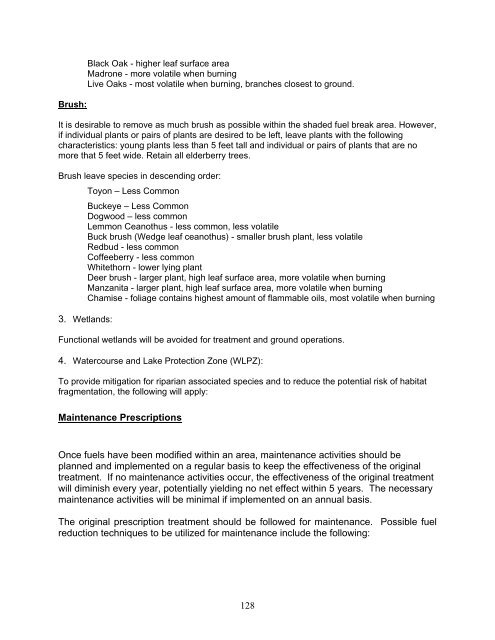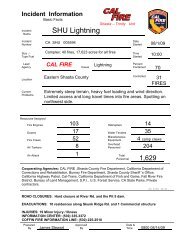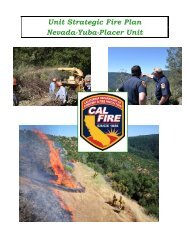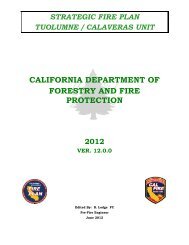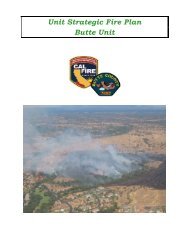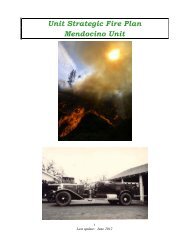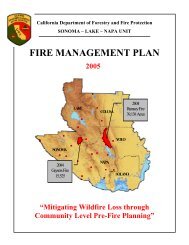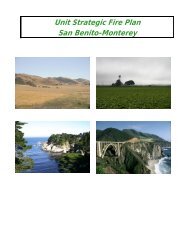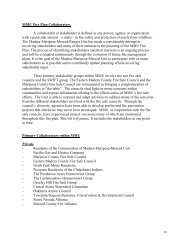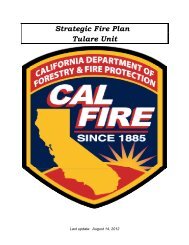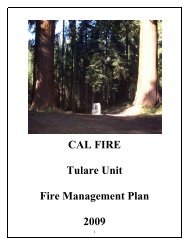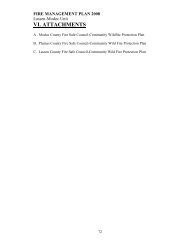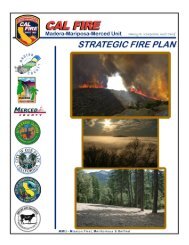Nevada-Yuba-Placer Strategic Fire Plan 2011 - Board of Forestry ...
Nevada-Yuba-Placer Strategic Fire Plan 2011 - Board of Forestry ...
Nevada-Yuba-Placer Strategic Fire Plan 2011 - Board of Forestry ...
You also want an ePaper? Increase the reach of your titles
YUMPU automatically turns print PDFs into web optimized ePapers that Google loves.
Brush:<br />
Black Oak - higher leaf surface area<br />
Madrone - more volatile when burning<br />
Live Oaks - most volatile when burning, branches closest to ground.<br />
It is desirable to remove as much brush as possible within the shaded fuel break area. However,<br />
if individual plants or pairs <strong>of</strong> plants are desired to be left, leave plants with the following<br />
characteristics: young plants less than 5 feet tall and individual or pairs <strong>of</strong> plants that are no<br />
more that 5 feet wide. Retain all elderberry trees.<br />
Brush leave species in descending order:<br />
Toyon – Less Common<br />
Buckeye – Less Common<br />
Dogwood – less common<br />
Lemmon Ceanothus - less common, less volatile<br />
Buck brush (Wedge leaf ceanothus) - smaller brush plant, less volatile<br />
Redbud - less common<br />
C<strong>of</strong>feeberry - less common<br />
Whitethorn - lower lying plant<br />
Deer brush - larger plant, high leaf surface area, more volatile when burning<br />
Manzanita - larger plant, high leaf surface area, more volatile when burning<br />
Chamise - foliage contains highest amount <strong>of</strong> flammable oils, most volatile when burning<br />
3. Wetlands:<br />
Functional wetlands will be avoided for treatment and ground operations.<br />
4. Watercourse and Lake Protection Zone (WLPZ):<br />
To provide mitigation for riparian associated species and to reduce the potential risk <strong>of</strong> habitat<br />
fragmentation, the following will apply:<br />
Maintenance Prescriptions<br />
Once fuels have been modified within an area, maintenance activities should be<br />
planned and implemented on a regular basis to keep the effectiveness <strong>of</strong> the original<br />
treatment. If no maintenance activities occur, the effectiveness <strong>of</strong> the original treatment<br />
will diminish every year, potentially yielding no net effect within 5 years. The necessary<br />
maintenance activities will be minimal if implemented on an annual basis.<br />
The original prescription treatment should be followed for maintenance. Possible fuel<br />
reduction techniques to be utilized for maintenance include the following:<br />
128


